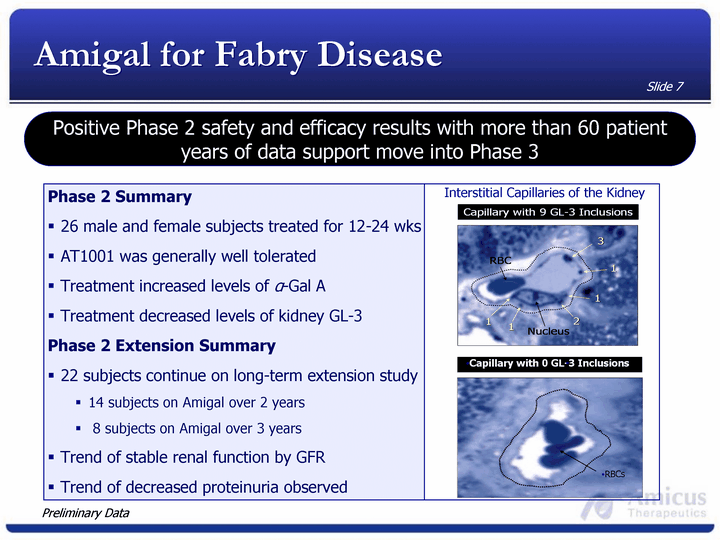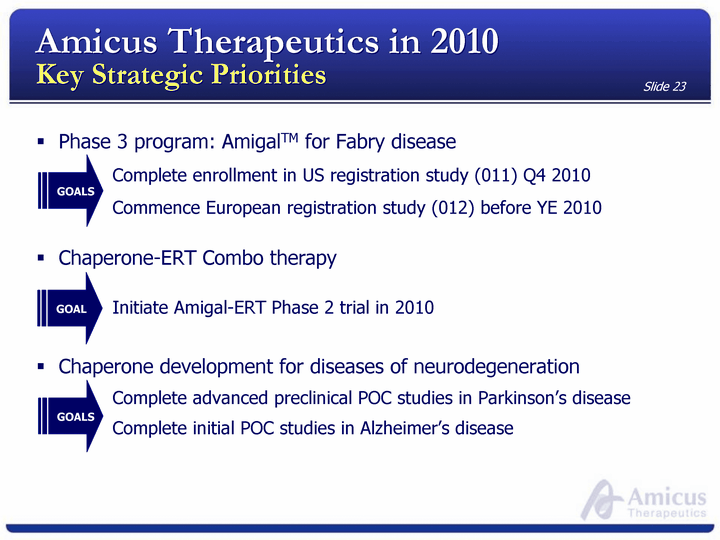Attached files
| file | filename |
|---|---|
| 8-K - FORM 8-K - AMICUS THERAPEUTICS, INC. | c94539e8vk.htm |
| EX-99.2 - EXHIBIT 99.2 - AMICUS THERAPEUTICS, INC. | c94539exv99w2.htm |
Exhibit 99.1

| 28th Annual J.P. Morgan Healthcare Conference John F. Crowley President and CEO |

| Safe Harbor This presentation contains certain "forward-looking statements" within the meaning of the Private Securities Litigation Reform Act of 1995 relating to the business, operations and financial condition of Amicus, including but not limited to preclinical and clinical development of Amicus' candidate drug products, the timing and reporting of results from preclinical studies and clinical trials evaluating Amicus' candidate drug products, and the projected cash position for the Company. Words such as, but not limited to, "look forward to," "believe," "expect," "anticipate," "estimate," "intend," "likely," "should" and "could," and similar expressions or words, identify forward-looking statements. Although Amicus believes the expectations reflected in such forward-looking statements are based upon reasonable assumptions, there can be no assurance that its expectations will be realized. Actual results could differ materially from those projected in Amicus' forward looking statements due to numerous known and unknown risks and uncertainties, including the "Risk Factors" described in our Annual Report on Form 10-K for the year ended December 31, 2008, and our other public filings with the Securities and Exchange Commission. Amicus does not undertake any obligation to publicly update any forward-looking statement to reflect events or circumstances after the date on which any such statement is made, or to reflect the occurrence of unanticipated events. |

| Amicus Therapeutics in 2010 Key Strategic Priorities Phase 3 program: AmigalTM for Fabry disease Complete enrollment in US registration study (011) Q4 2010 Commence European registration study (012) before YE 2010 GOALS Chaperone development for diseases of neurodegeneration Complete advanced preclinical POC studies in Parkinson's disease Complete initial POC studies in Alzheimer's disease GOALS Chaperone-ERT Combo therapy Initiate Amigal-ERT Phase 2 trial in 2010 GOAL |

| AT2220 Parkinson's Disease Pipeline Leveraging Versatility of Technology Platform Advancing Amigal Phase 3 program and other significant opportunities Preclinical Phase 1 Phase 2 Phase 3 AmigalTM Fabry Disease Pompe Disease ERT Combo Therapy ERT Combo Therapy Alzheimer's Disease Monotherapy Monotherapy PliceraTM Gaucher Disease ERT Combo Therapy |

| AmigalTM for Fabry Disease |

| Amigal for Fabry Disease Global Phase 3 study to support US registration ongoing Patient enrollment expected to be completed Q4 2010 Results expected mid-2011 Confident in probability of success Positive Phase 2 and Phase 2 extension study data Appropriate Phase 3 entry criteria Clear path to registration through agreements with FDA and EMEA Established market opportunity First oral treatment option for Fabry Significant upside potential Amigal Phase 3 program is our number one priority |

| Amigal for Fabry Disease Global Phase 3 Study to Support US Registration Ongoing Clear path to registration Accelerated approval 6 month study: Amigal versus placebo Surrogate primary endpoint of the change in kidney interstitial capillary GL-3 Foundation for success Eligibility criteria will enrich for subjects with responsive mutations and elevated kidney GL-3 Positive Phase 2 and Phase 2 extension study data ~30 sites worldwide First patient dosed Q409 |

| Preliminary Data Amigal for Fabry Disease Phase 2 Summary 26 male and female subjects treated for 12-24 wks AT1001 was generally well tolerated Treatment increased levels of ^-Gal A Treatment decreased levels of kidney GL-3 Phase 2 Extension Summary 22 subjects continue on long-term extension study 14 subjects on Amigal over 2 years 8 subjects on Amigal over 3 years Trend of stable renal function by GFR Trend of decreased proteinuria observed Capillary with 0 GL-3 Inclusions - RBCs Interstitial Capillaries of the Kidney Positive Phase 2 safety and efficacy results with more than 60 patient years of data support move into Phase 3 |

| Amigal for Fabry Disease Phase 2 Data Support Phase 3 Development Note: Preliminary 48 week data from Fab-202 and Fab-203; 1 subject completed only 12 weeks Phase 2 data in subset of subjects on the Phase 3 dose and regimen were encouraging across all key parameters Five male subjects on 150 mg QOD Enzyme levels increased 5 to 41-fold in WBCs and kidney Mean 63% reduction of GL-3 in kidney interstitial capillaries and mean 46% in urine Stable renal function by GFR and reductions in proteinuria |

| Amigal for Fabry Disease Significant Commercial Opportunity 2001A 2002A 2003A 2004A 2005A 2006A 2007A 2008 2009 2010 2011 2012 2013 2014 2015 2016 2017 2018 2019 2020 Other 26.46 168.84 395.01 815.22 1142.82 1351.98 1606.5 1810.62 1996.47 2171.12 2330.14 2486 2638.12 2795.08 2957.86 3122.52 3295.03 3468.84 3645.01 3827.92 Cannibalized 15.54 99.16 231.99 478.78 671.18 794.02 943.5 1063.38 1172.53 1287.88 1482.86 1743 2089.88 2470.92 2861.14 3200.48 3444.97 3659.16 3876.99 4124.08 Amigal Growth 0 0 0 0 0 0 0 0 0 11 99 245 468 718 973 1183 1307 1404 1503 1624 Non-addressable mutations Fabry Patients Addressable mutations Amigal Monotherapy Fabry Market (2008) is $670MM+ with 18%+ CAGR (1) Sales and CAGR based on 2008 company 10Ks; (2) Future market growth extrapolated from JP Morgan, AG Edwards, SG Cowen and Credit Suisse projections through 2010 |

| Chaperone-ERT Combo Therapy |

| Chaperone-ERT Combo Therapy Expansion of Chaperone Technology Reduce loss of activity in the circulation Increase effectiveness of ERT Improve safety of ERT Decrease quantity of ERT with reduced infusion time and costs Preclinical data suggest Pharmacological Chaperones have the potential to significantly enhance ERT safety and efficacy Potentially applicable to all ERTs and other recombinant proteins |

| Amigal Increases Fabrazyme(r) Stability Denaturation Time Course of Fabrazyme at pH=7.4 Fabrazyme alone Percent folded rhGLA (Fabrazyme) +- 10 ?M AT1001 at 37 °C + 10 ^M Amigal 0% 50% 100% 0 5 10 15 20 25 Time (hrs) % Folded Fabrazyme |

| Amigal Increases Fabrazyme Tissue Uptake Skin Heart Kidney ?-Gal A Activity ?-Gal A Activity ?-Gal A Activity AT1001 (mg/kg) AT1001 (mg/kg) AT1001 (mg/kg) Untreated 1 mg/kg Fabrazyme |

| Amigal Increases GL-3 Clearance by Fabrazyme Skin Heart Kidney GL-3 (% untreated) GL-3 (% untreated) GL-3 (% untreated) AT1001 (mg/kg) AT1001 (mg/kg) AT1001 (mg/kg) Untreated 1 mg/kg Fabrazyme |

| Amigal for Fabry Disease Treatment Options for all Patients 2001A 2002A 2003A 2004A 2005A 2006A 2007A 2008 2009 2010 2011 2012 2013 2014 2015 2016 2017 2018 2019 2020 Other 26.46 168.84 395.01 815.22 1142.82 1351.98 1606.5 1810.62 1996.47 2171.12 2330.14 2486 2638.12 2795.08 2957.86 3122.52 3295.03 3468.84 3645.01 3827.92 Cannibalized 15.54 99.16 231.99 478.78 671.18 794.02 943.5 1063.38 1172.53 1287.88 1482.86 1743 2089.88 2470.92 2861.14 3200.48 3444.97 3659.16 3876.99 4124.08 Amigal Growth 0 0 0 0 0 0 0 0 0 11 99 245 468 718 973 1183 1307 1404 1503 1624 Non-addressable mutations Fabry Patients Addressable mutations Amigal Monotherapy Amigal-ERT Combo Therapy Fabry Market (2008) is $670MM+ with 18%+ CAGR Potential to treat entire patient population PCs offer the potential to address a sizeable late-onset Fabry population (1) Sales and CAGR based on 2008 company 10Ks; (2) Future market growth extrapolated from JP Morgan, AG Edwards, SG Cowen and Credit Suisse projections through 2010 |

| Chaperone-ERT Combo Therapy Next Steps Additional proof-of-concept data to be presented at WORLD LSD Conference in February 2010 Plan to initiate Phase 2 clinical study with Amigal and ERT in 2010 Evaluating options to advance programs in Pompe disease and Gaucher disease Preclinical proof-of-concept established in Fabry and Pompe |

| Pharmacological Chaperones for Diseases of Neurodegeneration |

| Parkinson's Disease & Gaucher Disease An Established Genetic Link Gaucher carriers have an estimated 5-fold increased risk for Parkinson's disease Multiple independent studies in different populations Mutations in the gene (GBA) now considered most common genetic risk factor for Parkinson's disease The New England Journal of Medicine N Engl J Med 2009;361:1651-61 |

| Significant Advancements in Parkinson's Increasing GCase Leads to Synuclein Reduction Untreated PC-Treated Vehicle 3 weeks 15 weeks 15 weeks Synuclein Synuclein/NeuN Established proof-of-concept in Parkinson's animal models Prevention of synuclein in accumulation in the brain Improvements in behavioral characteristics and motor function Lead molecules selected with strong IP |

| Alzheimer's Disease Program Pharmacological Chaperone Approach ^-amyloid and P-Tau are hallmarks of Alzheimer's disease Potential to use pharmacological chaperones to increase activity of target enzymes decrease ^-amyloid and P-tau Apparent link between various lysosomal enzymes and accumulation of ^-amyloid and P-Tau deposits in the brain Proceedings of the National Academy of Science Proc Natl Acad Sci USA 2009;106:8332-7 Next Steps: Complete initial POC studies in 2010 |

| Advanced POC data and IND candidate selection 2010 Key Milestones POC data in PD animal model Ph 2 Ext. Study data Complete patient enrollment in Phase 3 "011" trial AT2220-ERT Combo Therapy preclinical POC data Initiate Phase 2 study of Amigal-ERT Combo therapy Target validation and initial POC data Phase 1 PK data Amigal-ERT Combo Therapy preclinical POC data AmigalTM Fabry Disease AT2220 Pompe Disease Parkinson's Disease Alzheimer's Disease Q1 Q2 Q3 Q4 Commence Phase 3 "012" trial PliceraTM Gaucher Disease Plicera-ERT Combo Therapy preclinical POC data |

| 2010 Financial Strategy Expected cash balance YE 2009 ~$78M 2010 projected cash burn ~$40-50M Current cash projected to last into 2H 2011 Evaluating all opportunities in 2010 to build on financial strength, including possible partnerships: Fabry Ex-US Chaperone-ERT Combo programs Parkinson's disease Alzheimer's disease Financial strength and discipline to advance key strategic priorities |

| Amicus Therapeutics in 2010 Key Strategic Priorities Phase 3 program: AmigalTM for Fabry disease Complete enrollment in US registration study (011) Q4 2010 Commence European registration study (012) before YE 2010 GOALS Chaperone development for diseases of neurodegeneration Complete advanced preclinical POC studies in Parkinson's disease Complete initial POC studies in Alzheimer's disease GOALS Chaperone-ERT Combo therapy Initiate Amigal-ERT Phase 2 trial in 2010 GOAL |

| 28th Annual J.P. Morgan Healthcare Conference John F. Crowley President and CEO |
